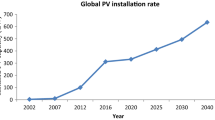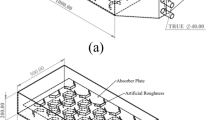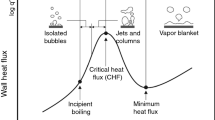Abstract
A double-glazed window separating a small scale room and the cold environment outside it are modeled by such a window joining a hot box to a cold one. The effects of different parameters on the heat transfer from the hot box (room) to the cold box (outside) are investigated experimentally. These parameters include: the size of the air gap between the double-glazed window, installation of a curtain in the air gap, the curtain to window distance behind the double-glazed window and tilting the double-glazed window from its vertical position. Although the results of these investigations are qualitatively predictable, a comprehensive experimental study to quantify the share of each individual item on the heat loss through the window is a reasonable research. The results indicate that increasing the air gap from 12 to 21 mm, results in 5.1% less energy loss through the window. By installing the curtain in the middle of a 21 mm air gap, the energy loss reduces by 19.9% compared to the same air gap but without a curtain. Also, by installing the curtain at a distance of 0.4 to 4 cm behind the window on the hot side, a 22% to 33.9% reduction in energy loss is observed. A tilt angle of 10° from vertical position can decrease the energy loss by 6.5%. Numerical studies with the Ansys Fluent 16 software provide good agreement with the experimental data. These numerical studies are conducted for one case in each set of experiments and help to study parameters that changing them in experimental work is costly and time consumable.

















Similar content being viewed by others
Abbreviations
- \( {\overline{Q}}_{heater} \) :
-
The average heat generation rate of hot box heater(W)
- Δt :
-
Summation of all time periods in which the hot box heater is on(s)
- ΔT :
-
A long time period in which the average heat generation rate of hot box heater is measured(s)
- t :
-
Time(s)
- P :
-
Pressure(pa)
- V :
-
Velocity(\( \frac{m}{s} \), \( \frac{cm}{s} \))
- g :
-
Gravitational constant(\( \frac{m}{s^2} \))
- e :
-
Internal energy per unit mass(\( \frac{j}{kg} \))
- T :
-
Temperature(K)
- u j :
-
The component of velocity in direction j(\( \frac{m}{s} \))
- K :
-
Conductivity (\( \frac{W}{mK} \))
- K glass :
-
Glass conductivity (\( \frac{W}{mK} \))
- A glass :
-
Surface of hot or cold side glass(m2)
- \( {\dot{q}}_{generation} \) :
-
Heat generation rate per unit volume(\( \frac{W}{m^3} \))
- T 0 :
-
reference temperature in Boussinesq equation(K)
- q i :
-
The net rate at which radiation leaves surface i(W)
- A i :
-
The area of surface i(m2)
- J i :
-
Radiosity of surface i(\( \frac{W}{m^2} \))
- G i :
-
Irradiance of surface i(\( \frac{W}{m^2} \))
- E bi :
-
The rate at which black surface i emits(\( \frac{W}{m^2} \))
- q ij :
-
The net rate at which radiative heat transfer occurs from surface i to j(W)
- F ij :
-
View factor(\( \frac{q_{ij}}{A_i{j}_i} \))
- \( {\overline{q^{"}}}_{heater} \) :
-
The average heat flux of hot box heater(\( \frac{W}{m^2} \))
- T middle :
-
Temperature of a point inside the hot box or cold box which is located at middle (K)
- T down _ left :
-
Temperature of a point inside the hot box which is located at down_left (K)
- T down _ right :
-
Temperature of a point inside the hot box which is located at down_right (K)
- T top :
-
Temperature of a point inside the hot box or cold box which is located at top (K)
- T down :
-
Temperature of a point inside the cold box which is located at top (K)
- T right :
-
Temperature of a point inside the cold box which is located at right (K)
- \( {\overline{T}}_{glazing\ surface\ next\ to\ hot\ box} \) :
-
The mean temperature of glazing surface next to hot box(0K)
- \( {\overline{T}}_{hot\ side\ glazing} \) :
-
The mean temperature of total glazing surface next to hot and guard box (0C)
- \( {\overline{T}}_{\mathrm{cold}\ side\ glazing} \) :
-
The mean temperature of total glazing surface next to cold box (0C)
- T 1 :
-
The mean surface temperature of hot glass on the side adjacent to the air gap (0C)
- T 2 :
-
The mean surface temperature of cold glass on the side adjacent to the air gap (0C)
- L :
-
The distance between the two pieces of glass (mm)
- \( {\overline{Q}}_{air\ gap} \) :
-
The average heat transfer rate through double glazed window (W)
- \( {\overline{Q}}_{air\ gap\_ radiative} \) :
-
The average radiative heat transfer rate through double glazed window (W)
- \( {\overline{Q}}_{air\ gap\_ convective} \) :
-
The average convective heat transfer rate through double glazed window (W)
- Ra air gap :
-
Flow Rayleigh number in the air gap
- Nu air gap :
-
Flow Nusselt number in the air gap
- \( {\overline{T}}_{curtain} \) :
-
The average temperature of curtain surface(K)
- \( {\overline{T}}_{\mathrm{hot}\ \mathrm{box}} \) :
-
The volume average temperature of hot box (0C)
- d :
-
The distance between curtain and glazing surface next to hot box(m)
- h :
-
Convective heat transfer coefficient (\( \frac{W}{m^2K} \))
- A glazing surface next to hot box :
-
The area of glazing surface next to hot box(m2)
- μ :
-
Dynamic viscosity(pa. s)
- ρ :
-
Density(\( \frac{kg}{m^3} \))
- ρ 0 :
-
reference density in boussinesq equation(\( \frac{kg}{m^3} \))
- β :
-
Thermal expansion coefficient (K−1)
- β air :
-
Thermal expansion coefficient of air (K−1)
- ν air :
-
Kinematic viscosity of air (\( \frac{m^2}{s} \))
- α air :
-
Thermal diffusivity (\( \frac{m^2}{s} \))
- θ :
-
Tilt angle of double glazed window from vertical position(°)
- τ ij :
-
Stress on an element surface(pa)
- ε i :
-
Emissivity of surface i
- ε curtain :
-
Emissivity of curtain surface
- ε glazing :
-
Emissivity of glazing surface
- σ :
-
Stefan–Boltzmann constant(\( \frac{W}{m^2{K}^4} \))
- δ glass :
-
Thickness of glass(m)
- Nu :
-
Nusselt number
- Ra :
-
Rayleigh number
References
Arıcı M, Karabay H (2010) Determination of optimum thickness of double-glazed windows for the climatic regions of Turkey. Energ Buildings 42:1773–1778
Shahid H, Naylor D (2005) Energy performance assessment of a window with a horizontal venetian blind. Energ Buildings 37:836–843
Wang K, Wu H, Meng Y, Zhang Y, Wei Z (2012) Integrated energy storage and electrochromic function in one flexible device: an energy storage smart window. Energy Environ Sci 5(8):8384–8389
Baker NMW, Taleb AM (2002) The application of the inclined window method for passive cooling in buildings. Archit Sci 45(1):51–55
Smith N, Isaacs N, Burgess J, Cox-Smith I (2012) Thermal performance of secondary glazing as a retrofit alternative for single-glazed windows. Energ Buildings 54:47–51
Oleskowicz-Popiel C, Sobczak M (2014) Effect of the roller blinds on heat losses through a double-glazing window during heating season in Central Europe. Energ Buildings 73:48–58
Hee WJ, Alghoul MA, Bakhtyar B, Elayeb O, Shameri MA, Alrubaih MS, Sopian K (2015) The role of window glazing on daylighting and energy saving in buildings. Renew Sust Energ Rev 42:323–343
Gloriant F, Tittelein P, Joulin A, Lassue S (2015) Modeling a triple-glazed supply-air window. Build Environ 84:1–9
Zhang C, Wang J, Xu X, Zou F, Yu J (2016) Modeling and thermal performance evaluation of a switchable triple glazing exhaust air window. Appl Therm Eng 92:8–17
Ghasemi B (2005) Reducing heat loss through double-glazed windows by changing the gas between glasses. The fourth international conference of fuel consumption optimization in building. Organization of fuel consumption optimization, Tehran
Aydın O (2000) Determination of optimum air-layer thickness in double-pane windows. Energ Buildings 32(3):303–308
Aydın O (2006) Conjugate heat transfer analysis of double pane windows. Build Environ 41(2):109–116
Arıcı M, Karabay H, Kan M (2015) Flow and heat transfer in double, triple and quadruple pane windows. Energ Buildings 86:394–402
Aguilar JO, Xaman J, Álvarez G, Hernández-Pérez I, López-Mata C (2015) Thermal performance of a double pane window using glazing available on the Mexican market. Renew Energy 81:785–794
De Giorgi L, Bertola V, Cafaro E (2011) Thermal convection in double-glazed windows with structured gap. Energ Buildings 43(8):2034–2038
Sun Y, Pei J, Zhang Y, Huang L, Zhou Y (2015) Analysis of indoor thermal comfort of test model building installing double-glazed window with curtains based on CFD. Procedia Eng 121:1990–1997
Wang D, Liu Y, Wang Y, Zhang Q, Liu J (2015) Theoretical and experimental research on the additional thermal resistance of a built-in curtain on a glazed window. Energ Buildings 88:68–77
Zhang C, Cheng K, Wang J, Xu X (2016) Numerical evaluation of heat recovery performance of a switchable exhaust air window. Energy Procedia 88:738–741
Carlos J (2017) Optimizing the ventilated double window for solar collection. Sol Energy 50:454–462
Wang J, Du Q, Zhang C, Xu X (2017) Energy performance of triple glazed window with built-in venetian blinds by utilizing forced ventilated airflow. Procedia Eng 205:3993–4000
Settles GS (2001) Schlieren and shadograph techniques, Visalizing phenomena in Trasparent media. Springer Verlag, Berlin
Blaszczuk A (2013) Experimental investigation of natural convection inside a upper part of vertical converging air channel using the Schlieren technique. Exp Thermal Fluid Sci 50:178–186
Tanda G, Fossa M, Misale M (2014) Heat transfer measurments in water using a Schlieren technique. Int J Heat Mass Transf 71:451–458
Incropera FP, DeWitt DP, Bergman TL, Lavine AS (2007) Fundamentals of heat and mass transfer 6th edn. Wiley
Hermans LJF (2007) Black vs. white. Euro Phys News 38(1):21–21
Yedder RB, Bilgen E (1995) Turbulent natural convection and conduction in enclosures bounded by a massive wall. Heat Mass Transf 38(10):1879–1891
Churchill W, Chu HHS (1975) Correlating equations for laminar and turbulent free convection from a vertical plate. Int J Heat Mass Transf 18:1323–1329
Author information
Authors and Affiliations
Corresponding author
Additional information
Publisher’s note
Springer Nature remains neutral with regard to jurisdictional claims in published maps and institutional affiliations.
Rights and permissions
About this article
Cite this article
Bitaab, M., Hosseini Abardeh, R. & Movahhed, S. Experimental and numerical study of energy loss through double-glazed windows. Heat Mass Transfer 56, 727–747 (2020). https://doi.org/10.1007/s00231-019-02729-4
Received:
Accepted:
Published:
Issue Date:
DOI: https://doi.org/10.1007/s00231-019-02729-4




